Walking past a garden with overgrown trees that seem to take up all the space gives an idea of why pruning is essential for trees. It is one of the basic steps to ensuring that your mature trees are well-maintained and completely healthy.
Pruning a mature tree is the selective removal of certain branches from a mature tree to improve its overall health. Pruning a mature tree ensures adequate access to plant resources like air and water. It also reduces overcrowding, which can be a burden on the tree’s resources, and improves the overall aesthetics of the tree.
Pruning, when done right, can resuscitate an unhealthy tree as it revitalizes the tree by cutting off all the unhealthy and unnecessary parts, which allows the healthy parts of the mature tree to have all the resources they need.
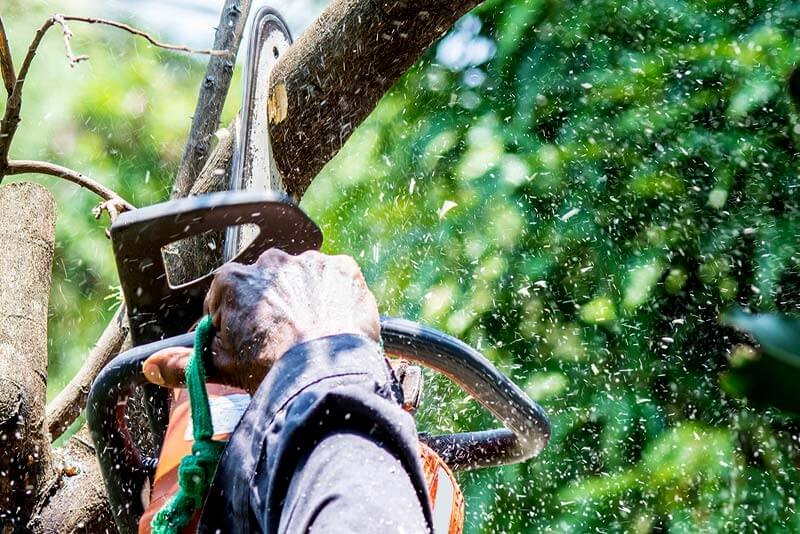
What branches should I trim?
This will depend on the purpose of the trim. If it’s to get more light to your lawn or home, then remove the lower branches from the tree. If it is to reduce the overall size, then you will tend to trim a little off all branches.
Pruning techniques for mature trees
Pruning techniques are the different ways mature trees can be pruned. Pruning a mature tree can be done by cleaning, thinning, raising or reduction pruning techniques.
The technique used in pruning the tree depends mainly on the desired end result. Whether you wish to reduce the tree branches or to increase the fruits the tree develops, there is a pruning technique that serves your needs.
Top 3 pruning techniques
Canopy reduction
Branch selection: Remove the outermost branches.
Where to cut: Remove the third to fourth-order branches.
Pro cost: High cost to trim.
DIY ease: Difficult. Will require advanced climbing skills or a cherry picker to get the job done.
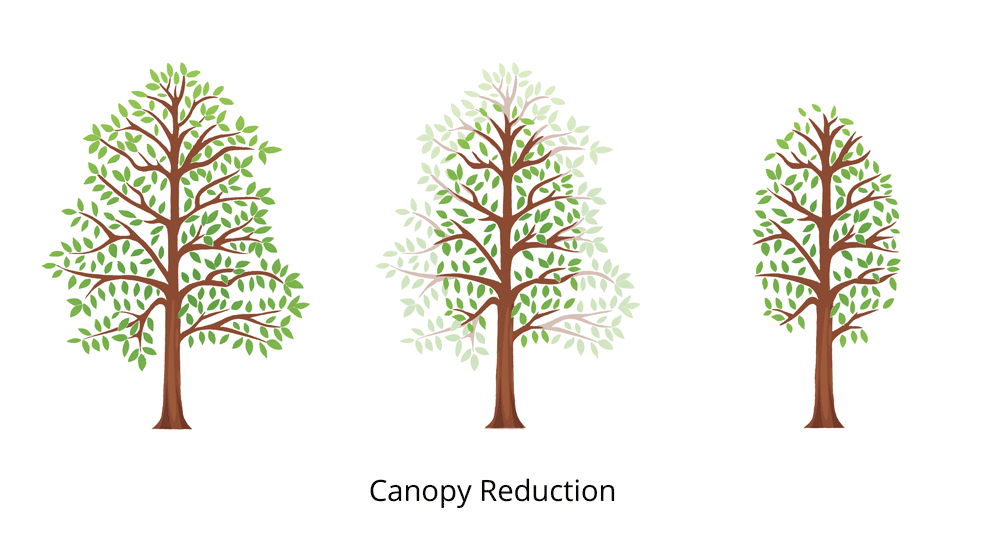
Canopy lift
Branch selection: Remove the lowest limbs on the tree.
Where to cut: Remove first-order branches back to the trunk.
Pro cost: Low cost to trim.
DIY ease: Quite an easy job depending on the size of the tree
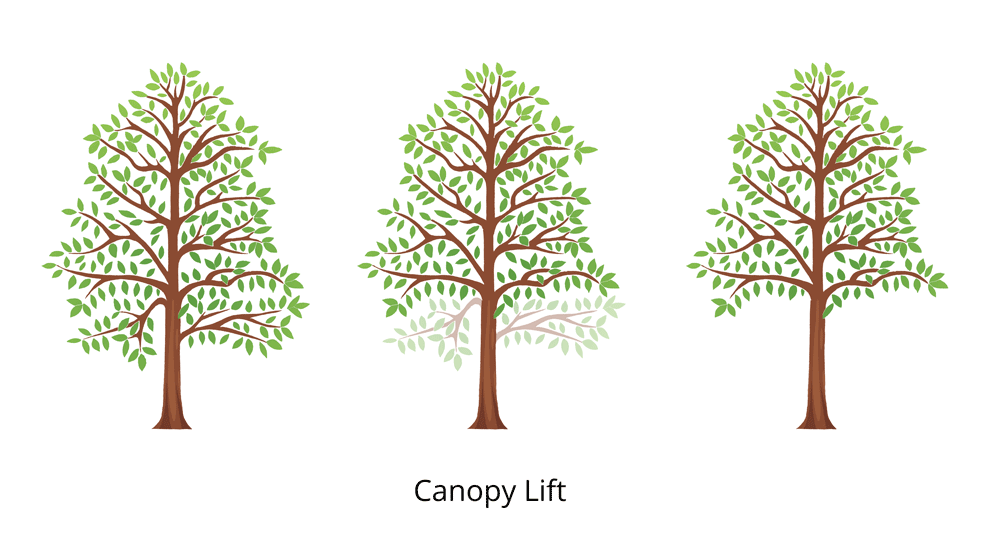
Canopy thinning
Branch selection: Remove selected branches within the canopy.
Where to cut: Remove the first, second and third-order branches
Pro cost: Med – high cost to trim.
DIY ease: Medium to hard. Will require the use of a harness and climbing saw
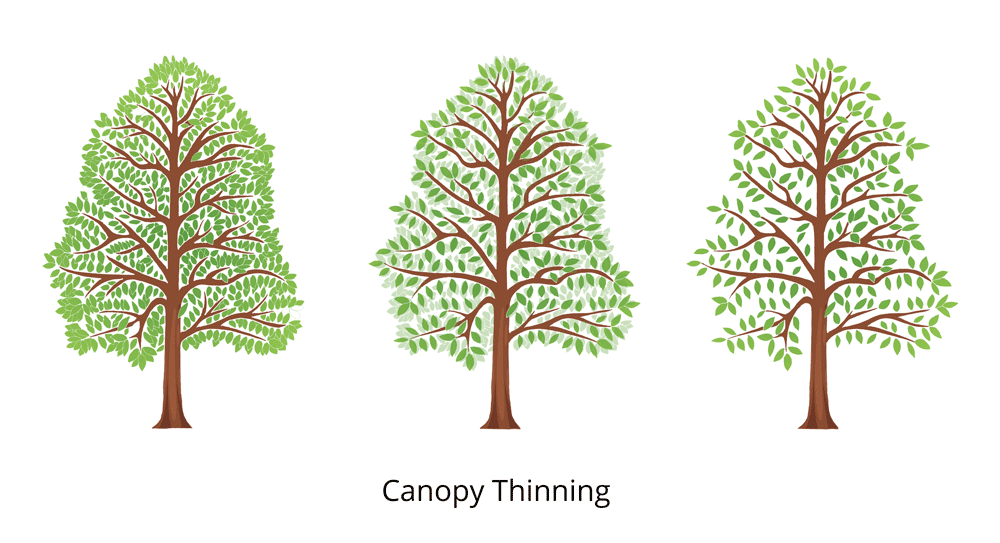
Making proper pruning cuts for mature trees
Making a proper pruning cut is very important. If the cut is not done right, it can lead to the tree being exposed to bacteria and pathogens that can cause diseases.
Here is the best way to make a proper pruning cut;
- Collar cut – When removing a branch you need to protect its structural integrity and allow it to heal properly. This is done by trimming the branch by leaving the collar
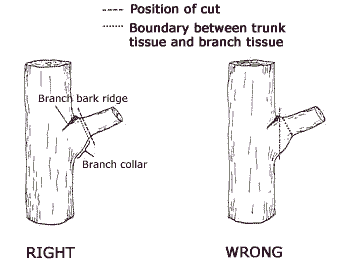
- Use very sharp equipment in the pruning of mature trees. A clean sharp cut will ensure faster healing and less damage to the mature tree.
- Step cut first – A step cut is used to avoid any tearing of the bark. See diagram below.
- First cut the underside of the branch ⅓ of the way through,
- Then make another cut further out.
- Third, make your collar cut.
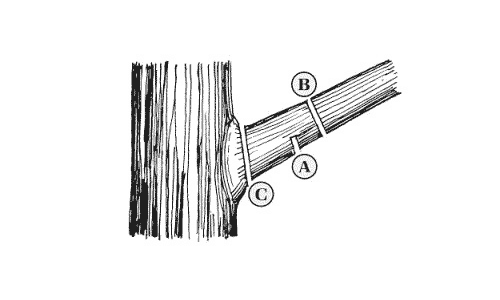
Reasons for pruning mature trees
Pruning is a very important step in ensuring that a mature tree is healthy. When you prune a tree, the shape and growth pattern of the mature tree is altered. There are many reasons why we prune mature trees and they include the following;
1. To change the shape of the mature tree
Certain trees may grow in unseemly patterns due to different reasons. However, pruning mature trees shapes the tree into a good and optimal position for healthy growth and development. People with small gardens can also prune their mature trees to keep the tree branches out of the neighbor’s yard or from growing into the street.
2. To manage the growth pattern of the tree
Before a tree is fully mature, pruning can help to manage the growth pattern. For example, homeowners with small gardens can prune their trees regularly to ensure that the tree remains at a manageable size and does not overcrowd the garden and other trees. This ensures that the tree grows exactly as you require.
3. As a way of preventing insect and pest infestation of mature trees
If a particular branch of a mature tree is infested with insects and pests that harm the tree, having the unhealthy branches of the tree pruning can ensure that the insects do not spread and infect the entire tree.
4. To limit disease damage to mature trees
Tree diseases of the leaves and the stem can be curtailed by pruning the mature tree. Pruning gets rid of any diseased or infected part of the tree and this ensures that the disease damage is limited and that the mature tree can be treated more effectively.
5. For aesthetics
When a mature tree is planted, it might be for ornamental value. Pruning a mature ornamental tree is very important as it can improve the aesthetics of your driveway or wherever they were planted. Some talented arborists will even shape the tree into whatever design you want.
When is the best time to prune mature trees?
Choosing the best time to prune your mature tree can be the difference between a healthy tree and a damaged tree. The best time to prune a mature tree will depend on the period of dormancy for that particular tree species.
The period of dormancy is that time of that tree’s life cycle after the tree is done fruiting but before the blooming of the flowers of the tree. During dormancy, the tree stops all unnecessary metabolic activities and conserves its resources. Some trees will begin this dormancy period by their leaves falling from the trees.
Pruning a mature tree during this time will ensure that the pruning will have minimal adverse effects on the tree but will instead help the tree to conserve more resources.
The best time to prune your mature tree is when it is in its dormant period. It can fall anywhere from the months of May to September. This depends on the season the tree blooms and fruits.
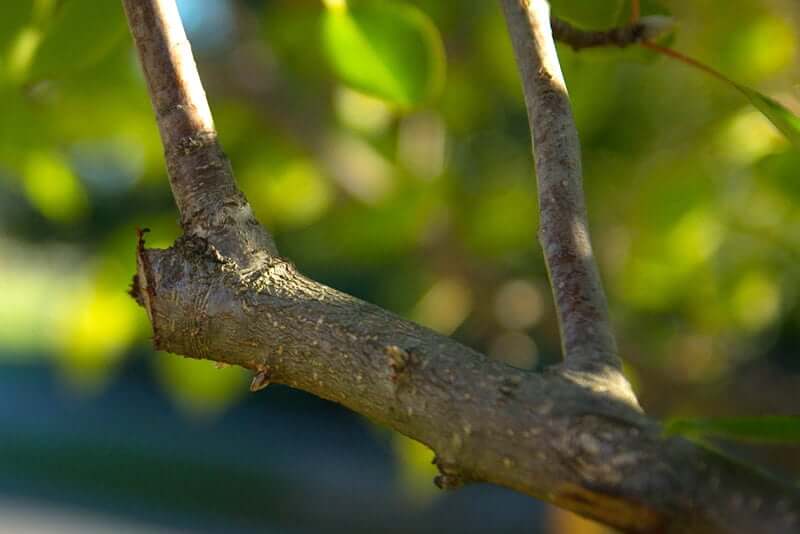
How much should be pruned from mature trees?
While pruning a mature tree making sure there is no long term damage is very important. This can be done by ensuring that the tree is not overpruned and loses major parts.
One rule to follow while pruning a mature tree is to ensure that no more than one-quarter of the tree’s leaf-bearing branches are removed.Making sure not more than one-quarter of a tree’s leafy branches is removed will ensure that the tree remains healthy and suffers little damage during pruning.
If more than one-quarter of a tree’s leaf bearing branches are removed, the risk of damage to the tree is greatly increased. The tree might not also recover as fast because of the greater loss of leafy branches. This is because the leaves undergo photosynthesis to provide food for the entire mature tree.
Wound dressings for mature trees
Applying wound dressing to a cut from a pruned branch is not advised by arborists as the cut needs air to heal as it facilitates the growth of cells that will heal the cut.
However, if the tree is an ornamental tree use an aerosol wound dressing and only apply a thin coat. This will ensure that the tree heals properly and prevents any lasting damage.
Can you DIY or hire an arborist?
When you decide to prune a mature tree, finding the best option on who is best equipped to prune the tree is important. An arborist is a professional but doing it yourself can also have its benefits.
In the table below, we are going to compare and contrast the differences between hiring an arborist or doing it yourself when it comes to pruning a mature tree.
| Arborist | DIY | |
|---|---|---|
| 1. | The Arborist is a professional trained in the science and art of pruning mature trees. | A DIY pruner is usually the homeowner, family and friends. |
| 2. | The Arborist understands every tree species and knows the appropriate steps to pruning a mature tree. | DIY pruning is usually guesswork and most times the DIYer does not fully understand the mature tree they have to prune. |
| 3. | The Arborist does little to no damage to the mature tree during pruning. | A DIY pruner might damage the mature tree while pruning due to lack of knowledge. |
| 4. | Hiring a professional arborist is very expensive. Arborists can charge up to $2,000 to prune mature large and tall trees especially if they need a lot of equipment to prune the tree. | A DIY pruning job is very affordable as the major cost if for equipments and labor is primarily free |
| 5. | If there is any damage caused by the arborist, there is tree insurance to cover the costs. | If the DIY pruner damages the mature tree, there is no insurance to cover the damages. |
While pruning your fence in a DIY project is affordable, when pruning a mature tree it’s better to hire an arborist. You can also hire a gardener as they are less expensive compared to an arborist and not as well trained.
When it comes to pruning a mature tree, making a mistake should be avoided at all cost as they do not heal as fast as their younger counterparts and any damage can leave a permanent mark.











